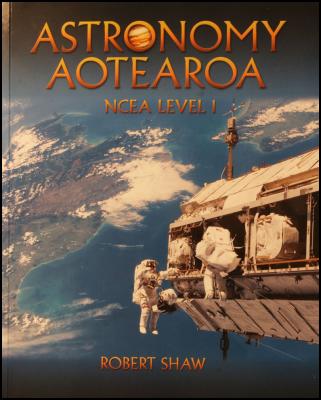NZ’s First Textbook on Astronomy and Space
New Zealand’s First Textbook on Astronomy and Space

Click to enlarge
www.pearsoned.co.nz
MEDIA RELEASE
New Zealand’s First Textbook on Astronomy and Space
Pearson Education New Zealand announces the first New Zealand text book on astronomy and space for secondary school students. The book is Astronomy Aotearoa by Porirua City author Robert Shaw.
The Hon Luamanuvao Winnie Laban formally launched the book on the 17 September 2007.
Minister Laban said “this book will capture the interest and imagination of readers, and hopefully inspire them to continue studying science”.
“More young New Zealanders – and especially more young Māori and Pasifika New Zealanders – need to consider a career in science in order for our country to compete and thrive in the global economy of the 21st Century” said Ms Laban.
Lewis Moeau spoke at the book launch on behalf of the Minister of Maori Affairs.
The book, Astronomy Aotearoa, teaches the new curriculum in astronomy and space exploration to secondary school students. This curriculum is in three unit standards and provides a total of 12 credits at NCEA level 1. Pearson Education New Zealand produced the book in cooperation with the Carter Observatory which was important in establishing the new school curriculum along with science teachers from throughout New Zealand.
The book begins by considering the students’ personal relationship to the stars and the planets. It challenges them to see themselves as insignificant in the vastness of space, yet significant in themselves.
It then considers the role of astronomy in the history of the Pacific Ocean peoples including the Maori. Maori text was contributed by Anaru Reedy of Te Wananga O Aotearoa. Mr Reedy is a student in the ancient Maaori art of wayfinding without instruments, and specialises in the art of sailing contemporary waka ama, and waka hourua.
Mr Reedy said the book introduces students to “an aspect of Maori culture that inspires many of our young people”. There is a section on the voyages of exploration of Asian and Pacific people and the colonisation of Pacific Islands including Aotearoa New Zealand.
The book teaches the history of Western Science. There is emphasis on leading figures such as Isaac Newton and Albert Einstein. Scientists appear as people along with an introduction to their theories. In all cases the book seeks to make science accessible to students of all abilities.
The book features the work of many New Zealand photographers including Wellingtonian Paul Moss. Mr Moss said many amateur photographers watch the sky and take unique photographs. “It is wonderful to see their work in print”.
Professional astronomers from Canterbury and Auckland universities feature, along with amateur astronomers who have made an important contribution to astronomy. Professors John Hearnshaw (Canterbury) and Phil Yock (Auckland) are prominent as the book sets out New Zealand’s contribution to science administration and astronomical research.
Of particular importance is the research of those in the MOA project, which detects planets outside of our solar system. New Zealanders have a leading role in this work that is relevant to humankind’s effort to detect intelligent life on other planets.
Pearson Education commissioning editor, Ken Harrop, said his company had a strong presence in mathematics education and Astronomy Aotearoa would strengthen its products in basic science.
“We see these areas of the curriculum as vital for New Zealand students and the economic development of our country”, he said.
Mr Harrop paid tribute to the astronomers and photographers who had supported the project. “There is a vast wealth of material available for such a book, particularly on the internet, and our design experts have been faced with the happy task of selecting the most dramatic and instructive items.”
He acknowledged the work of the author, Robert Shaw. “Robert was a physics teacher with a particular interest in astronomy. He took a leading part in the development of the new curriculum standards. Now he has completed that work by providing an interpretation of those standards that will guide science teachers for many years to come. We are delighted to have him as one of our authors.”
Aotea College principal Julia Davidson said the work would be important in the teaching of science throughout New Zealand. She said it was a “wonderful resource” that addressed a particular need in schools.
Minister Luamanuvao Winnie Laban also congratulated those involved. She said “I’d like to acknowledge Robert Shaw, and congratulate him on this wonderful book.
“I’d also like to thank Robert for his work in developing those unit standards when he was a manager of the Distance Education Unit and a member of the Carter Observatory Board” she added.
ENDS


 Royal Commission Covid-19 Lessons Learned: Public Submissions To The COVID-19 Inquiry Close On Sunday 27 April 2025 At Midnight
Royal Commission Covid-19 Lessons Learned: Public Submissions To The COVID-19 Inquiry Close On Sunday 27 April 2025 At Midnight Te Whatu Ora Health New Zealand: Low Risk To Public Health Following Fire At South Taranaki Hotel
Te Whatu Ora Health New Zealand: Low Risk To Public Health Following Fire At South Taranaki Hotel NZCTU: Govt Vocational Education Reforms Will Cause Massive Disruption
NZCTU: Govt Vocational Education Reforms Will Cause Massive Disruption NZ Liberation Museum - Te Arawhata: Anzac Day Commemorations In France To Remember All New Zealand Soldiers
NZ Liberation Museum - Te Arawhata: Anzac Day Commemorations In France To Remember All New Zealand Soldiers Royal Commission Covid-19 Lessons Learned: We Want To Hear From As Many People As Possible, Says COVID-19 Inquiry Chair
Royal Commission Covid-19 Lessons Learned: We Want To Hear From As Many People As Possible, Says COVID-19 Inquiry Chair My ECE: Parents Reject ECE Deregulation - 'Children’s Safety Is Not Optional'
My ECE: Parents Reject ECE Deregulation - 'Children’s Safety Is Not Optional'